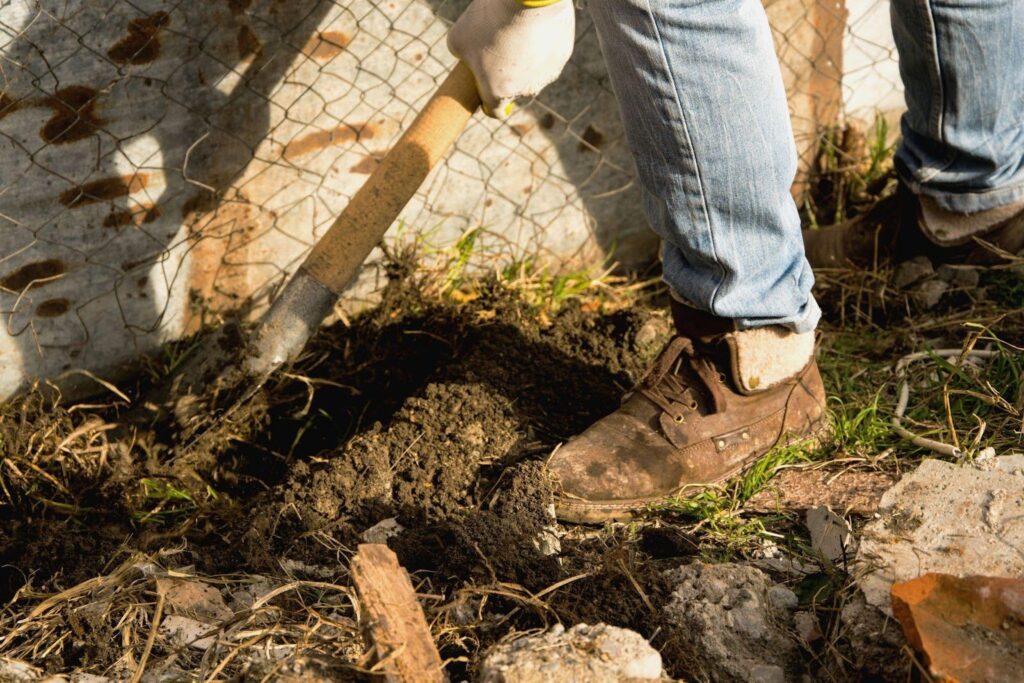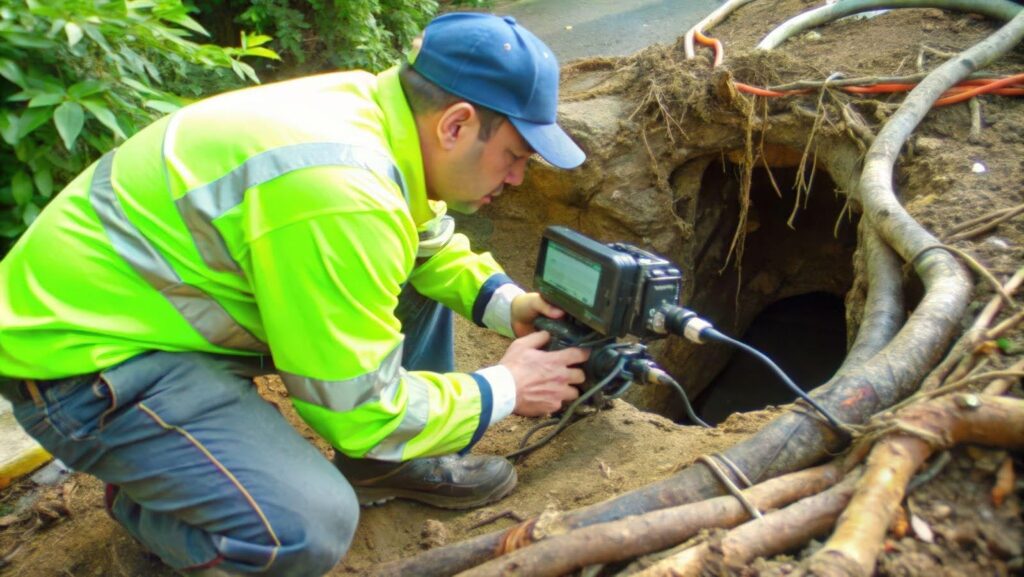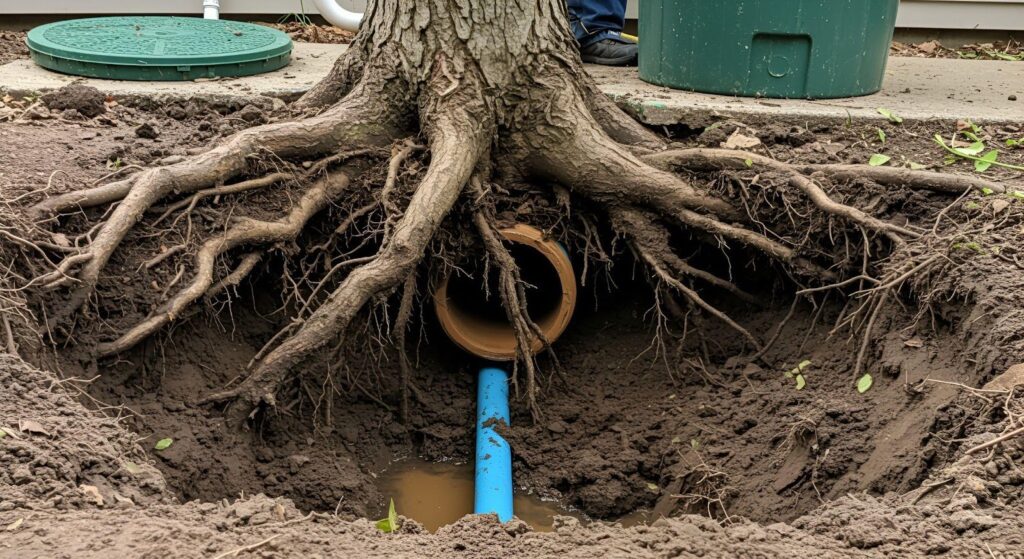If ignored, roots in your sewer line can cause clogs, damage, and costly repairs. Many homeowners mistake the early signs of damage for routine drain issues, but tree root intrusion is one of the most common causes of sewer line failure. Left untreated, roots grow into dense blockages that restrict water flow, break pipes, and lead to sewage backups.
In this blog, you’ll learn how roots enter your sewer system, the warning signs to watch for, the risks of waiting too long, and the professional solutions that restore your pipes. Protect your home and avoid expensive emergencies with the right maintenance and sewer cleaning.
Keep reading to learn more.
How roots get into sewer lines
Tree roots constantly search for moisture and nutrients underground; your sewer line provides both. When wastewater leaves your home, small amounts of vapor escape through tiny cracks, loose joints, or worn seals in the pipes. That moisture attracts nearby roots like a magnet.
Once roots reach the pipe, they squeeze into even the smallest opening. A hairline crack, an aging joint, or a weakened section of pipe gives roots the entry point they need.
At first, the roots are thin and thread-like. Over time, though, they thicken and spread inside the pipe, forming dense root masses that block water flow. What started as a small intrusion quickly grows into a serious plumbing problem.
This process explains why cleaning a sewer line once roots are inside is rarely a permanent fix. Even if you clean the main sewer line and clear the blockage, the roots will continue growing unless you seal the underlying cracks or openings.
Professional plumbers often use sewer cleaning methods like hydro jetting to clear the growth before recommending repairs or relining to stop the invasion for good.
Roots aren’t picky. Whether you have clay, cast iron, or even some types of plastic piping, they will find their way in if the pipe has weak spots. That’s why regular inspections and proactive maintenance matter so much.

Warning signs of root intrusion
Tree roots inside your sewer line don’t stay hidden for long. As they grow and spread, they cause clogs, backups, and damage, creating clear warning signs in your home and yard. Recognizing these symptoms early allows you to stop the problem before it becomes an expensive repair.
Slow drains
If sinks, tubs, or toilets take longer than usual to empty, it might not be a simple clog. Roots often create partial blockages that restrict water flow. You may try cleaning the sewer line with a plunger or drain cleaner, but the issue keeps returning. That’s a red flag for root intrusion.
Frequent clogs and backups
Frequent clogs and backups are another sign. If your toilet overflows regularly or multiple drains in your home clog simultaneously, it points to a blockage in the main sewer line. Roots have often grown into the pipe, forming a dense mat that traps waste and debris. You’ll need professional sewer cleaning to clear the line.
Gurgling sounds
You may also notice gurgling sounds coming from drains or toilets. Those noises happen when water struggles to push past a blockage. Over time, the pressure inside the pipe builds up and can cause cracks or collapse.
Wet or sunken patches
Outside, watch for wet or sunken patches in the yard. When roots damage a pipe, wastewater seeps into the soil, creating soft, soggy areas or even foul odors around your property.
Sewage smells
If you notice musty or rotten odors from drains, it could mean a main line clogged with roots. At that point, it’s very important to call a plumber for a camera inspection and professional cleaning of the main sewer line.
Catching these symptoms early prevents bigger problems, like complete pipe failure. The sooner you act, the easier and less costly it is to fix.
The risks of ignoring tree roots in sewer lines
Tree roots in your sewer line don’t stay small problems for long. If you ignore them, they keep growing until the damage becomes severe and expensive. What might begin as an occasional clog can escalate into a full-scale plumbing emergency.
Pipe damage
As roots grow thicker inside the line, they create pressure against the pipe walls. That pressure sometimes causes cracks to spread, joints to separate, or the pipe to collapse completely. Even repeated sewer line cleaning won’t solve the problem once the pipe structure fails. At that point, you may need a full replacement instead of a repair.
Raw sewage backup
During a main sewer line blockage, wastewater has nowhere to go but back into your home. Toilets may overflow, tubs and showers may fill with sewage, and strong odors can make your home unlivable. Beyond the inconvenience, this creates serious health hazards for your family.
Increased costs
Ignoring root intrusion also drives up costs. Regular sewer cleaning is far less expensive than dealing with emergency cleanup, pipe replacement, and property damage.
For example, replacing a collapsed sewer line costs several thousand dollars, while proactive maintenance like cleaning the main sewer line and sealing cracks helps prevent that outcome.
Impact on your yard and foundation
There’s also the hidden impact on your yard and foundation. Leaking sewage erodes soil, kills plants, and even creates soft spots threatening driveways, patios, or your home’s foundation. What seems like a plumbing issue quickly turns into a structural one.
The longer you wait, the harder and more costly the repairs become. Addressing root intrusion early protects your pipes, home, and wallet.

Professional solutions for root removal and pipe repair
When roots break into your sewer line, DIY methods only buy time. Real solutions require professional tools and expertise. Plumbers use proven techniques that remove roots and restore the health of your sewer system.
Hydro jetting
One of the most effective methods is hydro jetting. This process uses high-pressure water to blast roots, grease, and buildup out of the pipe. Unlike snaking, which only punches a hole through the blockage, hydro jetting clears the pipe wall completely.
It’s a good idea to pair it with a video inspection so the plumber can confirm the pipe is clean. Hydro jetting is a powerful form of sewer cleaning that restores normal flow and delays regrowth.
Mechanical auger or rooter machine
Another option is a mechanical auger or rooter machine. This tool has sharp rotating blades that cut through roots inside the pipe. While effective for immediate relief, the downside is that roots can regrow since the entry point isn’t sealed. That’s why plumbers often recommend follow-up treatments or repairs to keep roots from returning.
Pipe relining
For long-term solutions, pipe relining offers a way to repair without digging up your yard. To reline a pipe, a plumber inserts a flexible liner coated with epoxy into the damaged pipe, then inflates and cures it.
This creates a smooth, new surface inside the old pipe, sealing cracks and blocking future root intrusion. Relining also strengthens weakened sections, extending the pipe’s lifespan.
Pipe replacement
In severe cases where the pipe has collapsed or is beyond repair, pipe replacement becomes necessary. While traditional replacement involves excavation, many plumbers now offer trenchless methods that minimize digging. This approach protects landscaping while still giving you a durable new line.
Finally, every repair begins with a camera inspection. This step shows the exact location and severity of the roots. By pinpointing the problem, the plumber can recommend the right mix of cleaning, repairing, or replacing the sewer line.

Call Neighborly Plumbing today
Don’t let tree roots take over your sewer line. If you’ve noticed slow drains, foul odors, or repeated clogs, it’s time to act before the damage gets worse. Here at Neighborly Plumbing, we provide thorough inspections, professional sewer cleaning, and long-lasting repair solutions to keep your pipes flowing smoothly.
Whether you need help cleaning the main sewer line, clearing a stubborn blockage, or preventing future root intrusion, our team is ready to handle it all. Protect your home, yard, and peace of mind with reliable service from trusted professionals.
Schedule your sewer line inspection with Neighborly Plumbing today and stop roots in their tracks.





